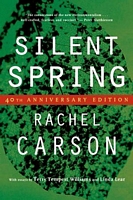Title: Silent Spring
Author: Rachel Carson
Publisher: Mariner 2002 (First published 1962)
ISBN: 0-618-24906-0
Pages: 300
The 40th anniversary edition of the world’s pioneering environmentalist book is no less appealing and relevant as it was four decades ago. Rachel Carson shot to prominence in environment friendly circles with her masterpiece when the world was only waking up to the dangers of a pesticide industry spawned from chemical warfare research during the second world war. With several examples of how the harmful chemicals damage the environment and the health of the people, Carson drove home the point to rein in the nascent industry before it was too late. This book was instrumental in forming public opinion which eventually led the ban of DDT in the U.S. and the formation of the Environmental Protection Agency (EPA) whose green-flag became mandatory for new projects.
Industry has developed many poisonous and biologically potent chemicals as pesticides which used indiscriminately against the plants and animals with widespread killing everywhere. Not only the pests, but the entire flora and fauna of the area is subjected to the devastating effects, so that these chemicals may be called biocides, instead of pesticides. The menace of pests grew to such large proportions when agriculture moved to large, single-crop, intensive farming style. Humans are also affected indirectly with the wide application of toxins, since the long-term health effects of the chemicals are not studied in sufficient detail.
The chemical pesticides come in two varieties, chlorinated hydrocarbons like DDT and organic phosphorous products like malathion. The harmful biological effects of the various products are given in good detail. Another form of toxins, called systemic insecticides which make parts of the crop plant harmful to insects also cause long term side effects. Chemicals sprayed on the crop often leech into ground water and surface water. Animals which drink the contaminated water accumulate on their tissues. Even though the original application was in low doses, the eventual building up of the chemical becomes lethal. Soil is also contaminated, which retains the toxicity for several years. The poison gets collected in crops too, by absorbing poison. Peanuts, which is an intercrop with cotton absorb benzene hexachloride (BHC) sprayed on cotton and become inedible. The farmers also suffer financial losses.
Weed control among the sides of the road and tourist places by spraying pesticides often destroy the natural beauty of scenic places, indiscriminately killing off attractive shrubbery and wild flowers, badly affecting the tourist potential. Biological control is the safe option here, in the absence of which selective spraying to remove trees and shrubs which obstruct drivers’ vision. By selectively cultivating shrubs, growth of trees can be prevented. As an example of biological control, planting marigold in rose buds wilted by nematode worms helped kill them off, due to a chemical secreted from marigold roots. Another illustrative example given is that of the Klamath weed, which which migrated along with man to America and flourished there because of lack of predators. As it caused economic impacts in several states, two species of beetles were imported from Europe which eventually reduced the weed to 1% of its previous spread. Carson rises the pertinent question that whether any civilized society can wage relentless war on life without destroying itself, and without losing the right to be called civilized.
One chapter is devoted to the logic behind the title of the book. In Michigan university campus, the dutch elm trees began to wilt due to a fungal attack spread by the bark beetle. The university uniformly sprayed DDT on to the trees in a bid to save them. The power accumulated on the leaves and bark, eventually reaching the soil and water. Earthworms ingested the chemical in their body which cycled to the digestive tracts of robins which ate them. The singing birds died en masse and the spring enlivened by robin’s songs became silent. Toxic sprays used to eradicate fire ants were carried off to rivers and streams, killing salmon schools. Such fish kill harms industry too, which provide food to millions. During the 50’s aerial spraying of chemicals was widespread causing maximum damage to the environment. This method was evidently a costlier and less efficient way rather than treating each mound specifically with lower dose chemicals.
Man is also a victim of his own poisoning. Human liver is driven to hard work to decompose pesticides like parathion and convert it to harmless products using the enzyme cholinesterase. Many chemicals hinder the production or action of these enzymes. This results in accumulation of toxins in body tissues, especially fat, as most pesticides dissolve in fat. This goes on normally until the fat is required to be metabolized during times of food shortage at which time ill effects appear. These poisons also may cause mental illnesses like memory loss to schizophrenia and depressive reactions. Genetic mutations are also observed in some cases. Writing in 1962, the field of genetics was still a nascent field, but Carson rightly picks up the potential hazards. Carcinogens are abundant in the toxic chemicals. These will easily exceed the safe limit as several exposures add up the content inside. A safe dose may come on top of another safe dose that it may be said that zero dose is the safe dose.
Insects developing resistance to pesticides is a nightmarish proposal, but that’s what several species had developed. This creates a vicious circle as more and more dosage is applied to kill the tough pests. Such chemical usage is like travelling in a long one-way street, where you don’t know where it will end. Resistance develops in the Darwinian fashion and can be as fast as a few weeks to several years. Biological control offers an excellent alternative way here too. Sterilizing insects by subjecting a control population to radiation is suggested. Another option is to breed the natural predators to the harmful insects, which too have been tested successfully in the field. Destroying the pests by targeting them to disease-causing bacteria like bacillus thuringiensis is lauded as a biological method, which however wouldn’t be approved by today’s environmentalists. Recent uproar in India over Bt Cotton which incorporated the disease-causing mechanism on the plant body.
The book was a splendid initiative, being the first popular version of scientific truths which usually appeared in peer-reviewed journals, out of reach for lay readers. The author’s long experience with the U.S. Fish and Wildlife Service is proved time and again by the barrage of apt examples and illustrations which drive home the point effectively. The book is also free of stereotypical affiliations, as she is not averse to limited and targeted use of chemicals. In an era when aerial spraying, which drenched humans and children in such dangerous toxins, this book was really an eye opener.
Some negative aspects should also be pointed out to keep a balanced view. It criticizes intensive crop farming as the cause of pests burgeoning. However, such farming is behind bumper harvests which feed the billions around the globe. The author’s praise for backyard farms where the pest problem is not severe is ill placed. The book is too much dependent on anecdotes. The incident of the scientist swallowing small dose of parathion unable to consume antidotes because of instant paralysis can only be conjecture. Also, to produce maximum startling effects of chemical spraying, comparisons are made to the effects of nuclear radiation. Even the list of water contaminants start with radioactive waste from reactors, labs, hospitals and fall out from nuclear explosions. Only then industrial pollution is listed! Such comparisons are clearly out of proportion. On some occasions the need to conserve is wrongly focussed. Saving water fowls and salmon is emphasized only because they provide recreation to hunting parties and anglers. The author’s laments on the disappearance of these beings are in terms of the wasted opportunities of pleasure, as “these people spend three billion dollars annually for licenses, tackle, boats, camping equipment, gasoline, and lodgings. Anything that deprives them of their sport will also reach out and affect a large number of economic interests” (p.139). Carson’s leaning on popular appeals might have been for influencing the public opinion. The futility of chemical pesticides are driven too far, in that she takes great pains to illustrate examples where the application of the chemical has caused economic damage to the farmer. However, such an argument is counter-productive and illogical. The farmers resort to chemicals because they are cheap, easy to obtain and apply. If it would have caused such financial investment and costs as the author makes out to be, no body would even use them in the first place!
The book is a must-read for every environmentalist and every student of science. It also shows how a book, written with sincerety and dedication can change public opinion in a beneficial way for the environment.
The book is highly recommended.
Rating: 4 Star













































No comments:
Post a Comment